
If you have a sunny patio arbor or pergola, then you have enough room to grow wine grapes. Most wine lovers will recognize the names of standard grape varieties, like ‘Pinot Noir’ and ‘Chardonnay’, but new wine grapes, like ‘Itasca’ and Pixie® Cabernet Franc, are continually being introduced, with desirable traits like cold hardiness and compactness. New wine grape traits such as these make homegrown winemaking an option for novice vintners across the country.
Wine, 10,000 Years in the Making
Wine grapes and man have had a long-standing relationship. Grapes (Vitis vinifera) originate from the Mediterranean where they have been foraged, grown, selected, and bred for over 10,000 years. Winemaking began as early as 7,000 years ago, becoming intrinsic to cultures across Europe, the Middle East, and Asia. The oldest-known winery was discovered in an Armenian cave, dating to 4,100 BC. Religion played a large role in refining winemaking and defining wine regions across Europe and the Middle East due to the importance of wine in Christian and Jewish ceremony.
France has a seriously dedicated wine history dating back to 2,600 years, and their wine grapes remain the gold standard for winemaking worldwide. US vintners favor varieties like ‘Cabernet Sauvignon’, ‘Chardonnay’, and ‘Merlot’ for their good quality and adaptability to our wine-growing regions. Though most associated with French winemaking, these grapes are also used to make other wines across Europe.
Most traditional wine grapes are marginally hardy, being bred in warmer climates, but most can be grown in USDA Hardiness Zones 6 or 7. Vines and grapes grow best in regions with mild winters and warm, dry summers that discourage disease and allow fruit flavors to intensify on the vine. This doesn’t mean there are not options for home growers living in colder or more humid parts of the country. Advances in disease-resistant grape root stocks have also made it easier to grow more finicky grapes in less favorable climates.
Traditional Wines Grapes
Reds
‘Cabernet Sauvignon’ (USDA Hardiness Zones 7-9)
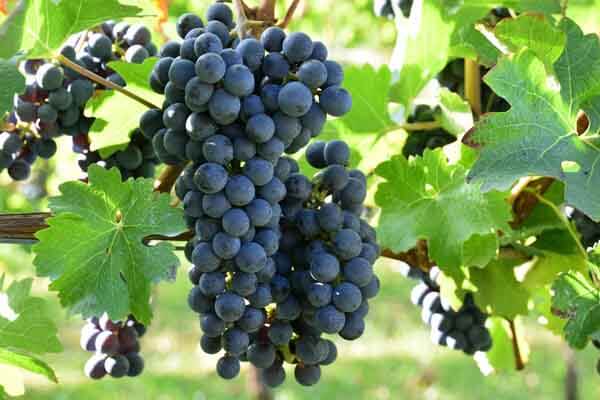 Selected in 17th century France from a cross between the red ‘Cabernet Franc’ and white ‘Sauvignon Blanc’, ‘Cabernet Sauvignon’ is one of the easier wine grapes to grow and ferment. Vines flower late, making them less susceptible to frost damage, and are naturally resistant to pests and fungal rot. Vines are low-yielding, but their clusters of blue-black fruits are good quality, resulting in wines that are tannic, acidic, and full-bodied when young, and robust, fruity, and peppery as they age. Vines grow best in gravelly soils with excellent drainage. Space vines 4-6 feet apart.
Selected in 17th century France from a cross between the red ‘Cabernet Franc’ and white ‘Sauvignon Blanc’, ‘Cabernet Sauvignon’ is one of the easier wine grapes to grow and ferment. Vines flower late, making them less susceptible to frost damage, and are naturally resistant to pests and fungal rot. Vines are low-yielding, but their clusters of blue-black fruits are good quality, resulting in wines that are tannic, acidic, and full-bodied when young, and robust, fruity, and peppery as they age. Vines grow best in gravelly soils with excellent drainage. Space vines 4-6 feet apart.
‘Merlot’ (USDA Hardiness Zones 7-9)
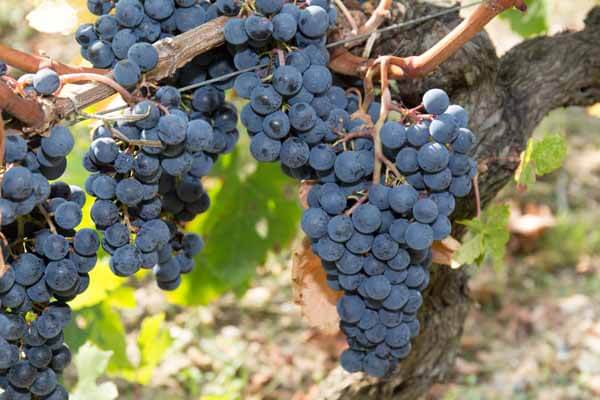 Developed in the western French Bordeaux wine region in the 18th century, ‘Merlot’ (French for ‘Blackbird’) is a hybrid cross between ‘Magdeleine Noire des Charentes’ and ‘Cabernet Franc’ grapes. It is noted for its early-to-bear blue-black grapes that are fleshy and soft. Early flowering makes this a more frost-sensitive variety, but the vigorous vines are high yielding. ‘Merlot’ grows well in deep, well-drained soils with some lime and clay. The grapes produce full-bodied, tannic wines that are very fruity. Space vines 4-6 feet apart.
Developed in the western French Bordeaux wine region in the 18th century, ‘Merlot’ (French for ‘Blackbird’) is a hybrid cross between ‘Magdeleine Noire des Charentes’ and ‘Cabernet Franc’ grapes. It is noted for its early-to-bear blue-black grapes that are fleshy and soft. Early flowering makes this a more frost-sensitive variety, but the vigorous vines are high yielding. ‘Merlot’ grows well in deep, well-drained soils with some lime and clay. The grapes produce full-bodied, tannic wines that are very fruity. Space vines 4-6 feet apart.
‘Pinot Noir’ (USDA Hardiness Zones 6-9)
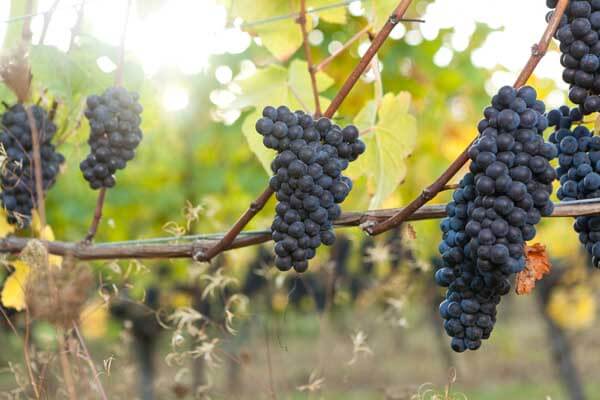 Originating from the Burgundy wine region of eastern France, Pinot Noir’ is an ancient variety traced as far back as the 1st century AD. Though quite hardy, this finicky grape is a lower yielder that can be challenging to transform into good wine, but when you succeed, its dry fruity wine is well worth the effort. Vines offer small, tight clusters of late-bearing, black grapes are thin-skinned, making them susceptible to fungal disease, so cultivation is easier in dry climates. It requires somewhat acid, loamy soils with excellent drainage. Space vines 3-4 feet apart.
Originating from the Burgundy wine region of eastern France, Pinot Noir’ is an ancient variety traced as far back as the 1st century AD. Though quite hardy, this finicky grape is a lower yielder that can be challenging to transform into good wine, but when you succeed, its dry fruity wine is well worth the effort. Vines offer small, tight clusters of late-bearing, black grapes are thin-skinned, making them susceptible to fungal disease, so cultivation is easier in dry climates. It requires somewhat acid, loamy soils with excellent drainage. Space vines 3-4 feet apart.
Whites
‘Chardonnay’ (USDA Hardiness Zones 7-9)
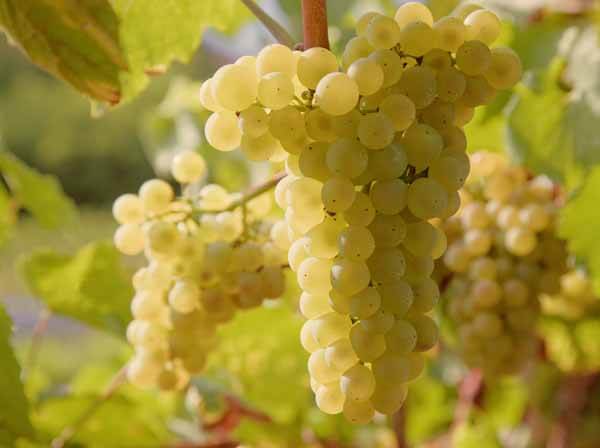 The origins of the ‘Chardonnay’ are traditionally associated with the French Burgundy wine region, but it may be traced earlier to vineyards of ancient Syria, Lebanon, and Cypress. Vines flower early, making them susceptible to frost damage. The high-yielding vines bear bunches of mild green grapes with flavor that is greatly influenced by the soils and climate where they are grown. But overall, its wines tend to be dry and fruity. ‘Chardonnay’ grapes grow and taste best when grown in mineral-rich, limey, chalky soils that are very well drained. Space vines 4-6 feet apart.
The origins of the ‘Chardonnay’ are traditionally associated with the French Burgundy wine region, but it may be traced earlier to vineyards of ancient Syria, Lebanon, and Cypress. Vines flower early, making them susceptible to frost damage. The high-yielding vines bear bunches of mild green grapes with flavor that is greatly influenced by the soils and climate where they are grown. But overall, its wines tend to be dry and fruity. ‘Chardonnay’ grapes grow and taste best when grown in mineral-rich, limey, chalky soils that are very well drained. Space vines 4-6 feet apart.
‘Sauvignon Blanc’ (USDA Hardiness Zones 6-10)

This grape comes from the Loire Valley and Bordeaux regions of western France where it is traced back to the 18th century. Later flowering and early fruiting make ‘Sauvignon Blanc’ a hardier grape that’s less susceptible to frost damage. Climate greatly impacts the flavor of this green grape, with cooler climates yielding greener flavors and warmer climates offering sweeter, fruitier flavors. Its wines have marked crispness and acidity. Vines are also very heat tolerant and should be spaced 4-6 feet apart.
‘Riesling’ (USDA Hardiness Zones 6-9)
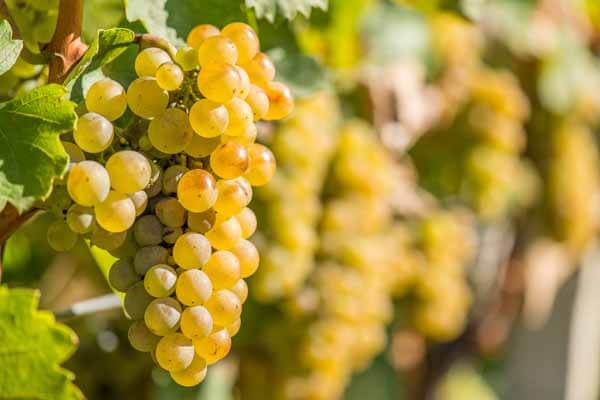 Originating from the Rhine region of Germany, ‘Riesling’ grapes date back to the 15th century. These aromatic, floral green grapes are quite hardy, though their flavor and sugar levels are greatly influenced by the growing environment. Cooler growing regions result in sweeter grapes, while warmer regions result in grapes with less sugar, resulting in drier wines. Vines grow best in deep, fertile soils with high mineral content. Space vines 4-6 feet apart.
Originating from the Rhine region of Germany, ‘Riesling’ grapes date back to the 15th century. These aromatic, floral green grapes are quite hardy, though their flavor and sugar levels are greatly influenced by the growing environment. Cooler growing regions result in sweeter grapes, while warmer regions result in grapes with less sugar, resulting in drier wines. Vines grow best in deep, fertile soils with high mineral content. Space vines 4-6 feet apart.
Hardy and Miniature Wine Grapes
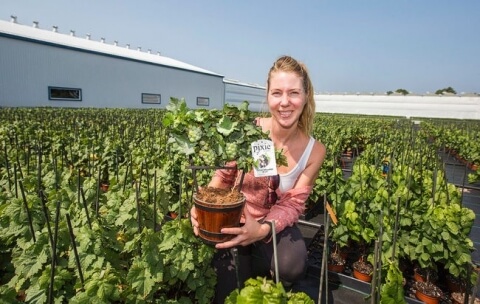
New wine grapes are being bred for cold places and small spaces. When it comes to small grapes, nothing can beat the new Pixie® grapes. The vines are so tiny they only reach 18- to 24-inches tall, making them perfect for large containers. Despite their small size, they quickly produce small bunches of fruit, which is good for adventuresome urban or small-space gardeners wishing to grow wine grapes. Pixie® grapes are available in ‘Riesling’, ‘Cabernet Franc’, ‘Pinot Meunier White’ and ‘Pinot Meunier Purple’ varieties. Grow these in OMRI Listed Black Gold Natural & Organic Potting Mix.
Minnesota State University has been at the forefront of superior hardy wine grape breeding. Of these, the deep-blue fruited ‘Marquette‘ is very hardy (USDA Hardiness Zones 4-9) disease resistant and produces complex wines with flavors of pepper and berries. The 2017 introduction, ‘Itasca‘ is a hardy (USDA Hardiness Zones 4-9), disease-resistant white wine variety with low acidity and high sugar content that produces floral wines with notes of pear and honey.
Wine Grape Terroir
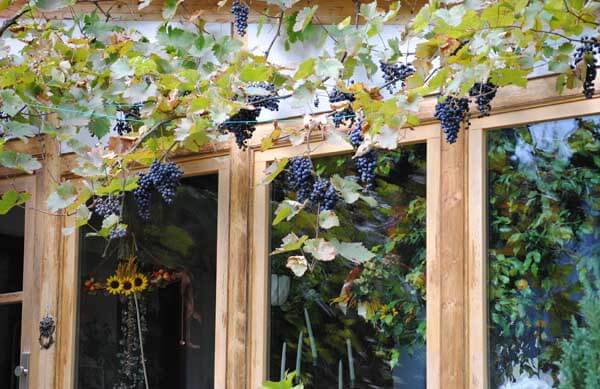
Terroir refers to the soil, topography, and climate where grapes are grown and impacts their flavor and success, from site to site and year to year. Upland soils that are slightly acid, rich in minerals, 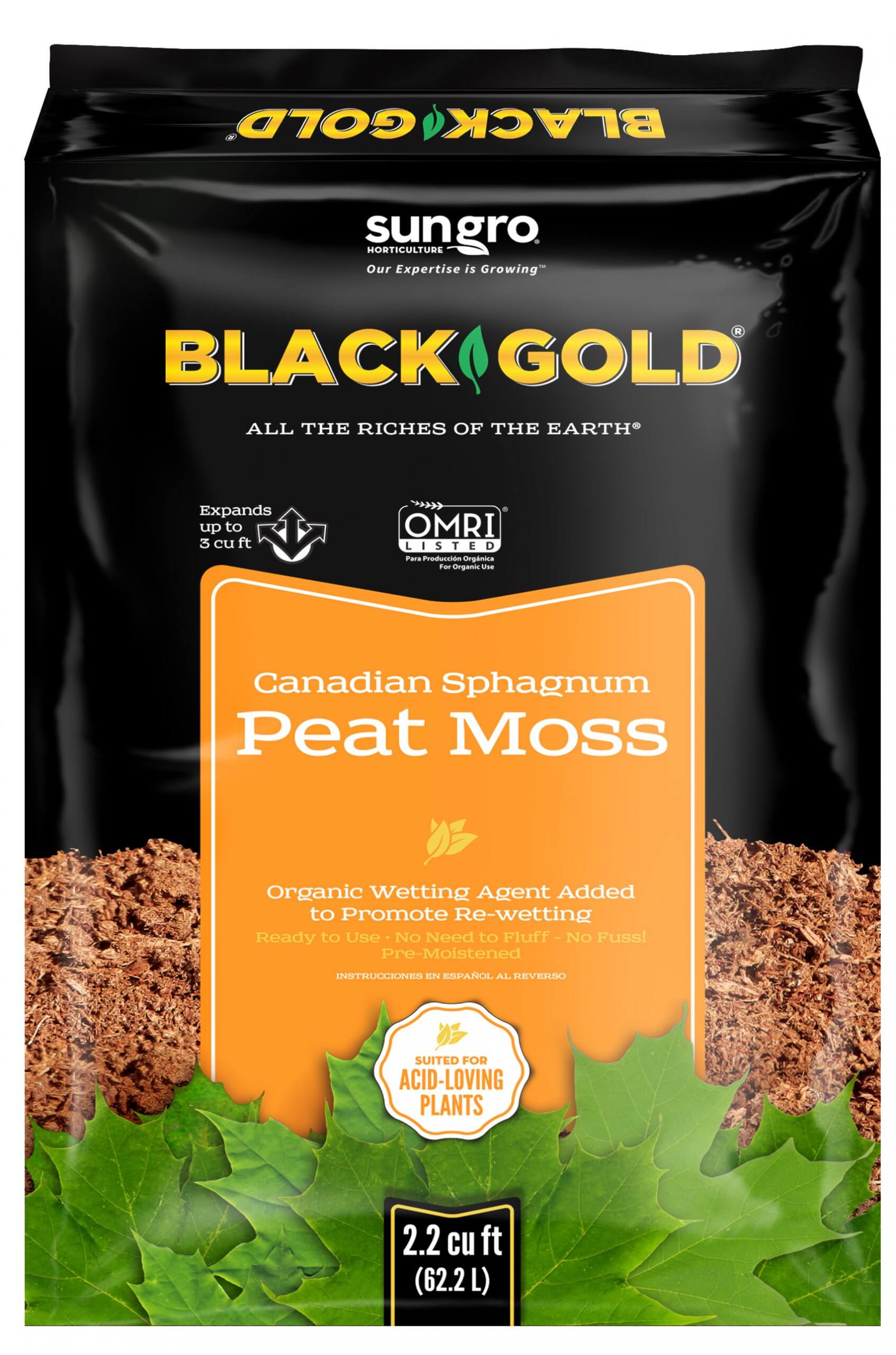 and well-drained are preferable. Lower humidity and rainfall during times of fruit development will reduce fruit fungal diseases and intensify flavors. Temperature also impacts grape sugar levels and flavor. When all elements are well aligned, good terroir results in good wine.
and well-drained are preferable. Lower humidity and rainfall during times of fruit development will reduce fruit fungal diseases and intensify flavors. Temperature also impacts grape sugar levels and flavor. When all elements are well aligned, good terroir results in good wine.
Climate cannot be modified, but you can do a lot to improve grape soils. Plant vines on high land in full-day sun and raise the soil. Enrich soils with Black Gold Canadian Sphagnum Peat Moss, lime, gravel, and even sand to improve drainage and mineral content. Be sure to fertilize vines with an OMRI Listed fertilizer formulated for grapes.
Plant grapes along arbors or in rows lined with 5-foot grape trellising constructed from wood and metal wire. Newly planted vines will take two to four years to bear fruit. Once established, happy grapes are very long-lived.
Maintenance and Disease
It is necessary to hard-prune mature grape vines yearly to minimize vine growth and maximize good fruit output. There are several pruning methods for wine grape establishment and maintenance. To learn more click here to read this useful article from WSU Extension on grape pruning.
Minimizing foliar overgrowth through pruning encourages airflow, which discourages fruit bunch rot, among other fungal diseases caused by too dense a canopy. Many more diseases plague grapes, which is why choosing disease-resistant stock is important. [Click here for a full online guide to grape diseases from Canadian Food & Ag.]
Make Wine!
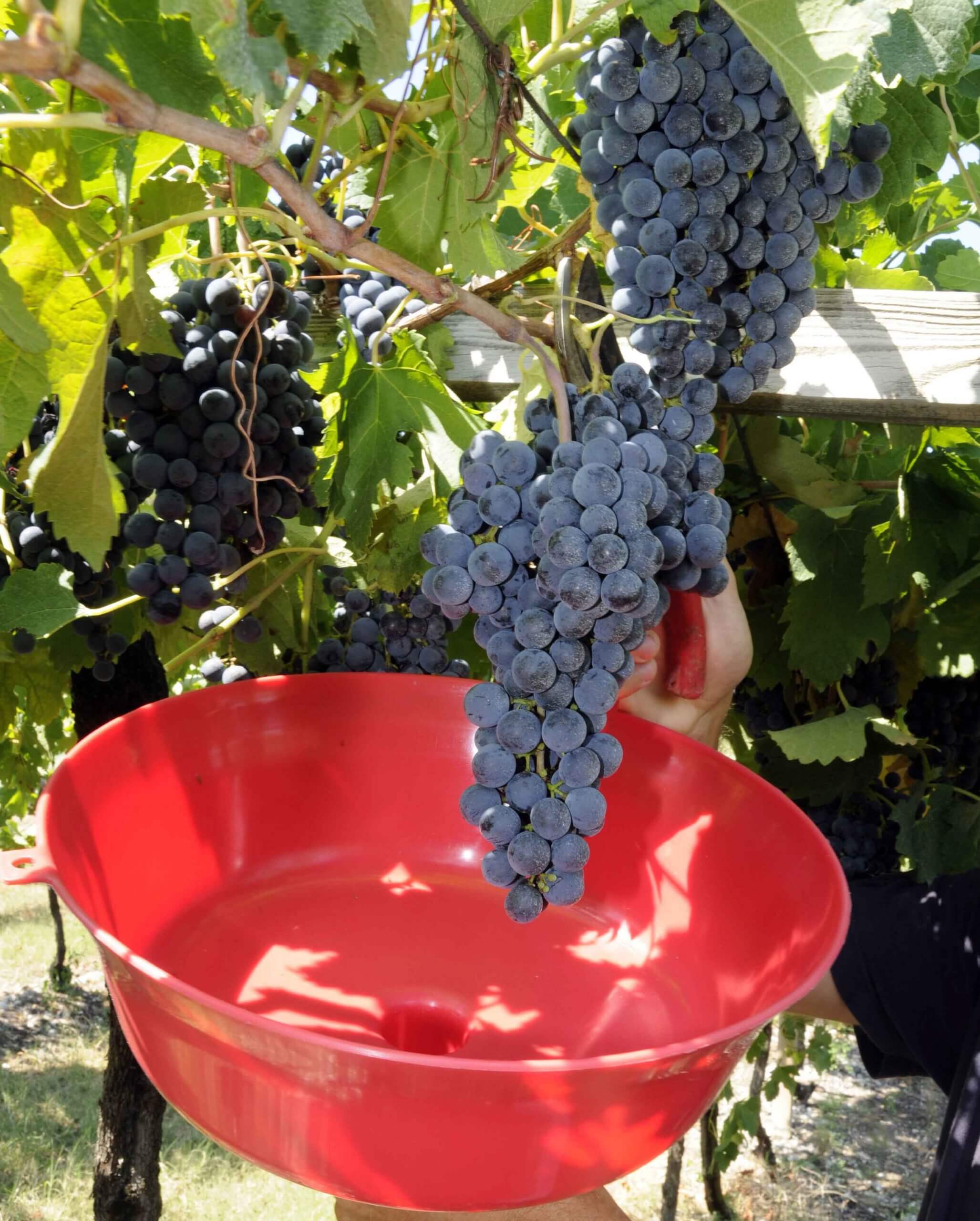 Once your grapes are fully colored and ripe, harvest them for home winemaking. Be sure to neatly cut full clusters from the vine, trying not to damage the fruits in the process.
Once your grapes are fully colored and ripe, harvest them for home winemaking. Be sure to neatly cut full clusters from the vine, trying not to damage the fruits in the process.
Federal law mandates that homeowners can generate 200 gallons of wine annually for personal consumption without paying tax. There are lots of good online resources to teach home winemaking. UC Davis even has a respected online winemaking certificate program, to help novice vintners learn the trade and make truly palatable homemade wines.

